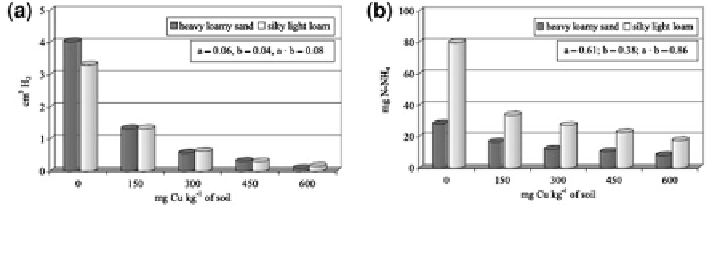Geoscience Reference
In-Depth Information
Fig. 18.5 The activity of a dehydrogenases (cm
3
H
2
/d/kg soil) and b urease (mg N-NH
4
/h/kg
soil), in copper-contaminated soils (modified after Wyszkowska et al.
2005
)
indicators of the activity of microorganisms in soil (Kiss
1999
), are found to be
good sensors for Cu
2+
contamination of soils. It can be seen from Fig.
18.5
that
the inhibition of the activity of these two enzymes, reflecting the decrease in the
activity of soil microbial communities, is closely associated with the amount of
copper added to the soil; the degree of inhibition varies among soils.
It is known, however, that soil microbial populations are responsible primarily
for the formation and stabilization of soil aggregates. Potential binding agents
among soil mineral particles include filamentous microbes (fungus hyphae),
metabolites produced by the decomposer, and organic substances anthropogeni-
cally introduced into the soil-subsurface medium (Guidi
1981
; Morel and Guckert
1983
). Experimental results confirmed that for soil-sludge mixtures in which
microbial activity was suppressed, no aggregative processes were recorded
(Metzger et al.
1986
; Metzger and Yaron
1987
). As a consequence, copper con-
taminants that impact negatively on soil microbial communities may indirectly
alter the process of aggregate formation and aggregate stability in soils. The degree
of Cu
2+
content controls the extent of aggregate formation and stability in con-
taminated soil, and defines the irreversibility of this process.
18.1.3 Soil-Subsurface Amendments
Properties of agricultural soils exhibiting extreme pH values are improved by
adding various forms of lime and gypsum. Successive application of these com-
pounds over many years has led to changes in soil properties which, on a lifetime
scale, become irreversible.
Lime Under natural conditions, acidic soils exhibiting a pH \*4.8 are formed
on weathered acidic rocks. This process occurs in a climatic regime where the
amount of rainwater exceeds the amount of water lost by evapotranspiration under
vegetation canopies. Soil acidification is a continuous process supported by the
natural input of very dilute carbonic acid and the leaching of weathering products.
However, soil acidification has increased from anthropogenic activities. On a
global scale, the acidification process has affected 10 million ha of cultivated land

